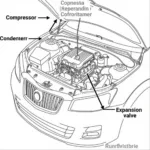Locating the OBD-II port, where you plug in your car diagnostic tool, can sometimes feel like a treasure hunt. This article will guide you through the process, explaining where to find this crucial connector in most vehicles and offering troubleshooting tips if you’re having trouble. Knowing where to plug in your car diagnostic tool is the first step towards understanding your vehicle’s health and performance. Let’s get started!
Knowing where to plug in your diagnostic tool, such as the ones found on car diagnostic tool ebay, is essential for any car owner. Understanding how this system works empowers you to take control of your vehicle’s maintenance.
Finding the OBD-II Port: A Step-by-Step Guide
The OBD-II port, short for On-Board Diagnostics, is a standardized 16-pin connector that allows you to access your car’s computer system. It’s typically located within reach of the driver’s seat, often underneath the steering wheel or dashboard.
- Check Under the Steering Wheel: The most common location for the OBD-II port is under the steering wheel column. Look for a trapezoidal connector with 16 pins.
- Explore the Dashboard Area: If it’s not under the steering wheel, check the dashboard area, particularly on the driver’s side or near the center console. It might be behind a small panel or cover.
- Look Near the Fuse Box: Sometimes, the OBD-II port is located near the fuse box, either under the dashboard or in the glove compartment.
- Consult Your Owner’s Manual: If you’re still struggling, your vehicle’s owner’s manual should provide the exact location of the OBD-II port.
Common OBD-II Port Locations by Car Make
While the OBD-II port is standardized, its exact location can vary slightly between car manufacturers. Here are some common locations for popular makes:
- Ford: Often found under the steering wheel, near the emergency brake pedal.
- Chevrolet: Typically located under the dashboard on the driver’s side.
- Toyota: Usually situated under the dashboard, near the steering column or center console.
- Honda: Commonly found under the dashboard, near the steering wheel.
For a better understanding of car diagnostics, you can refer to our article on car diagnostics definition. This provides a comprehensive overview of the process.
Troubleshooting Tips for Locating the OBD-II Port
Still can’t find it? Here are some additional tips:
- Use a Flashlight: A flashlight can be helpful in illuminating dark areas under the dashboard.
- Feel Around: Sometimes, you can locate the port by feeling around under the dashboard with your hand.
- Check Online Forums: Online forums specific to your car make and model can be a valuable resource for finding the OBD-II port location.
Understanding the Importance of the OBD-II Port
The OBD-II port allows you to connect a diagnostic tool, also known as a scan tool or code reader, to access your car’s computer system. This tool can retrieve diagnostic trouble codes (DTCs), which indicate potential problems with your vehicle. Knowing how to use a car diagnostic tool, such as the phunk kw850 odbii obd2 auto car diagnostic tool or the oldshark mini elm327 bluetooth obd2 v2.1 car diagnostic tool, can save you time and money on repairs. You can learn more about using these tools by reading our guide on how to run a diagnostic on car.
“Regularly checking your car’s systems using the OBD-II port can help identify potential issues before they become major problems,” advises Alex Thompson, Senior Automotive Technician at Precision Auto Repair. “It’s a proactive approach to car maintenance that can save you money in the long run.”
Conclusion
Knowing where to plug in your car diagnostic tool is crucial for any car owner who wants to understand and maintain their vehicle’s health. By following the steps outlined in this article, you should be able to locate the OBD-II port in your car with ease. Regularly using a diagnostic tool can empower you to take control of your car’s maintenance and prevent costly repairs.
FAQ
- What does OBD-II stand for? On-Board Diagnostics, version II
- Is the OBD-II port the same in all cars? The connector is standardized, but the location can vary.
- What can I do with an OBD-II scanner? Retrieve diagnostic trouble codes, monitor engine performance, and more.
- Do I need a professional to use an OBD-II scanner? No, many user-friendly scanners are available for DIYers.
- What if I can’t find my OBD-II port? Consult your owner’s manual or check online forums specific to your car make and model.
- Can I damage my car by using an OBD-II scanner? No, using a scanner correctly will not harm your car.
- Where can I buy a reliable car diagnostic tool? Reputable online retailers and auto parts stores.
Need help with car diagnostics? Contact us via WhatsApp: +1(641)206-8880, or Email: [email protected]. We have a 24/7 customer support team.

